HP Reverb G2 review: Sharper than reality?

HP's VR headset Reverb G2 promises to combine the sharp image of the predecessor with the comfort and sound of Valve Index. How does the VR headset compare to the predecessor and Valve Index?
In this review, you will find out
- how good the high-resolution display of Reverb G2 is,
- how comfortable the VR headset is,
- what the controllers and tracking are good for
- and for whom the headset is worthwhile.
Content
Resolution, colours and frame rate
As with the predecessor, the high resolution of HP Reverb G2 is the best feature of the VR headset. It resolves with 2,160 x 2,160 pixels per eye, which puts it at the top of consumer VR headsets along with Reverb G1. The frame rate is 90 hertz.
However, unlike what the pure numbers suggest, the image quality of the new model is much better than in the predecessor headset. I noticed that immediately.
Better lenses developed together with Valve, software improvements from Microsoft, and new display technology result in a crisp image that is almost free of light flashes (god rays), streaking effects (ghosting), or errors in color representation (chromatic aberration). The pixel structure of the display (Screen Door Effect) is no longer visible – everything seems like it was made from one piece.
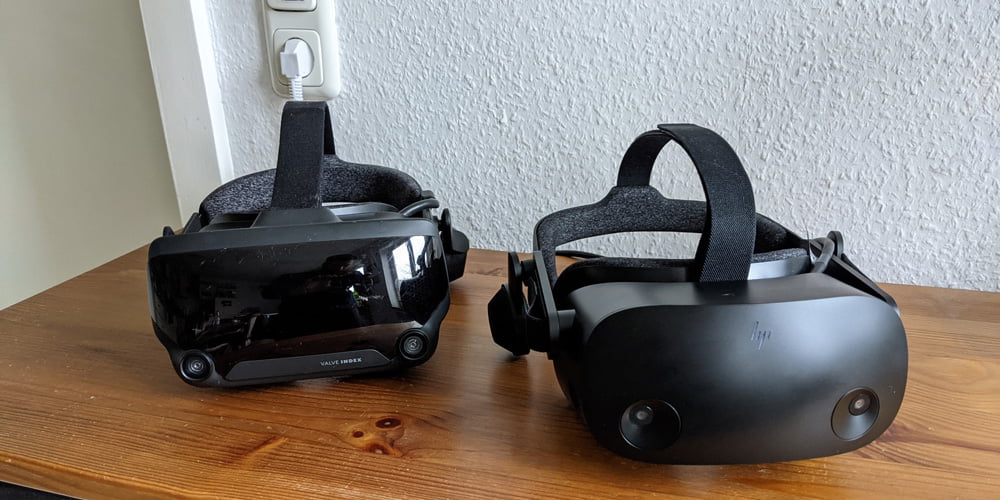
HP Reverb G2 and Valve Index have some similarities at first glance. | Image: MIXED
Thanks to the sharp and detailed image, details on weapons and textures can be seen in Half-Life: Alyx, for example, which I am missing even on the already high-resolution Valve Index (review).
In Elite Dangerous, I can see all displays and texts well, and they remain crisp even at a distance. For an LC display, the HP Reverb G2 also offers surprisingly good black levels: The stars stand out brightly against the darkness of outer space. That looks better than the predecessor or Valve Index.
The VR experience with Reverb G2 is similar to the viewing experience of a Blu-ray remaster of an old classic: You discover details that you have never seen before, and the whole experience is taken to a new level.
Of course, the high image sharpness comes at a price: SteamVR sets the resolution of HP Reverb G2 to 3,184 by 3,096 pixels per eye by default. This is standard and is done with all VR headsets to counteract the distortion effects of the lenses.
However, with an already very high native resolution like the Reverb G2's one, this will melt even strong graphics cards depending on the title. Lower resolutions reduce the performance effort, but the picture still looks great – even if the brilliance of the native resolution is lost.
HP Reverb G2: Field of view, sweet spot and eye distance
Besides the crisp image, something else immediately caught my eye when I first put it on, which is less pleasing: the narrow field of view. The field of view of VR headsets always depends on the distance between the eyes and the shape of the head, but the field of view of HP Reverb G2 is much narrower than Valve Index and other VR headsets.
Since Reverb G2, unlike Valve Index, does not offer the possibility to mechanically bring the lenses closer to the face, only more tension on the head strap helps for maximum contact pressure of the VR headset: Because the closer the eyes get to the lenses, the wider the field of view becomes.
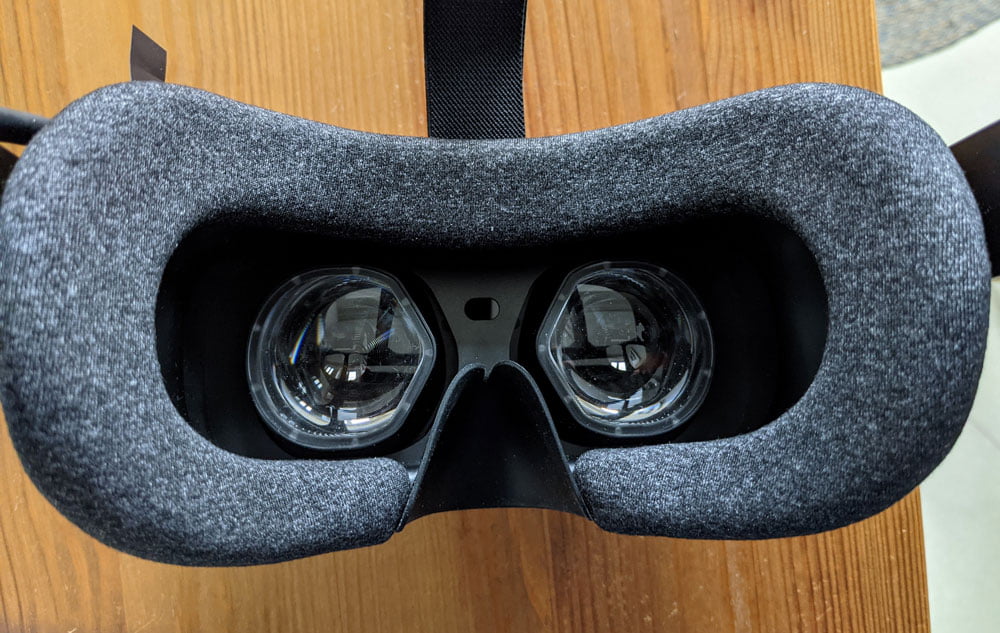
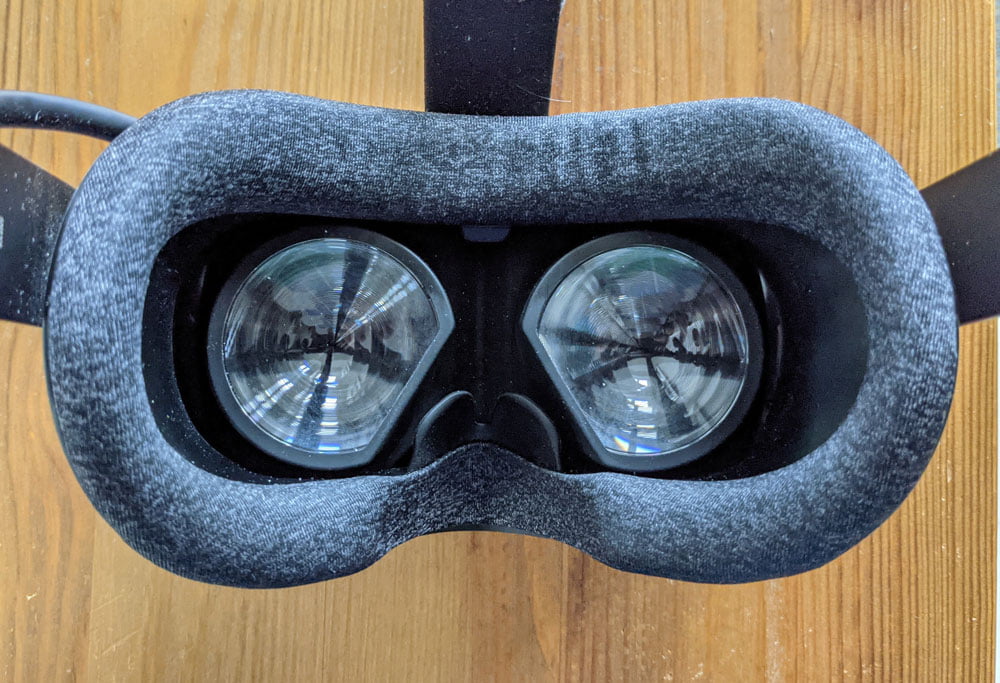
A look inside reveals the differences between Reverb G2 (top) and Index (bottom). The lenses are smaller and cut differently. The face pad is wider, but not as high as on the Index. | Image: MIXED
If I adjust the HP headset accordingly, the field of view is about on par with an HTC Vive for me – that's fine. However, longer gaming sessions are hard to bear with so much pressure on the face.
In practice, this means that during longer use, I have to live with a field of view that is below that of my HTC Vive, which is more than 4.5 years old. VR enthusiasts therefore partly build and print their face inlays and use other pads that reduce the distance to the lenses and thus expand the field of view while maintaining good wearing comfort. Those who want to make this modding effort can still optimize the field of view.
The narrower standard field of view is one of the two big immersion killers of Reverb G2 for me. However, if you're not used to Pimax or Index field of views, you'll probably notice it less. Nevertheless, it would have been nice if HP could have added a few degrees to the field of view.
Pleasing for me as a fish eye (IPD: 72 mm) is the mechanical regulator for the interpupillary distance (IPD). Reverb G1 didn't offer that at all, G2 can be adjusted between 60 and 68 millimeters. This allows me to better adjust the sweet spot, which is the sharpest area in the center of the lens, to my visual needs. That is a big step forward.
The sweet spot itself is fine for me, although I am noticing the drop-off in sharpness towards the edges more noticeable than with my Valve Index. A reason for this is that the difference between the sharp image center and the less sharp image edges is visible more clearly due to the high resolution of Reverb G2.
Conversely, however, I have to adjust the fit of my Index more precisely to find the sweet spot. Other users may have entirely different experiences, though. As with the field of view, the head shape of the VR wearer, and thus the fit of the VR headset, is crucial for the individual VR experience, in addition to the lenses themselves. VR headsets are also pieces of clothing, after all.
Sits well, sounds good – if it fits
The cooperation between HP and Valve is most evident in the design of HP Reverb G2: The VR headset features a similar head mount, an almost identical face pad, and the Index head speakers that hang elegantly in front of the ear instead of pressing against it.
This makes the VR headset much more comfortable than their predecessor. But it also makes compromises in some areas that will please the simulation target audience, but prevent Reverb G2 from knocking Valve Index off its throne as the most comfortable VR headset for me.
Like G1, Reverb G2 is significantly lighter than Index. As a result, it sits comfortably on the head, even during extended use. The head mount wraps around the back of the head and the entire mount has some clearance, making the VR headset relatively easy to put on and take off.
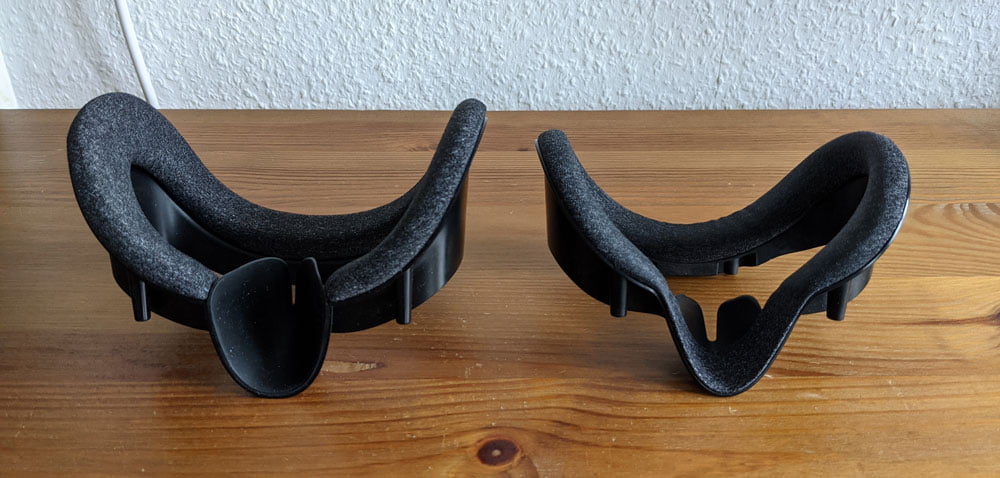
The HP Reverb G2's face pad (left) tapers more sharply, so it doesn't accommodate my face as well as the Valve Index's (right). Both are easy to remove and comfortable against the skin. | Image: MIXED
Unlike Index, however, G2 is tightened with Velcro strips. Here I like the solution of Index much better, which can be finely adjusted in seconds and with one hand with a knob at the rear.
The lack of a knob does have one advantage, though: The Reverb G2 is particularly well-suited for flight simulators or racing games, since players can lean their head against their chair without any problems and won't get stuck anywhere when turning.
The six-meter cable also contributes to the user comfort. It is attached to the headset via a clip, and long and flexible enough even for extensive room scale VR adventures.
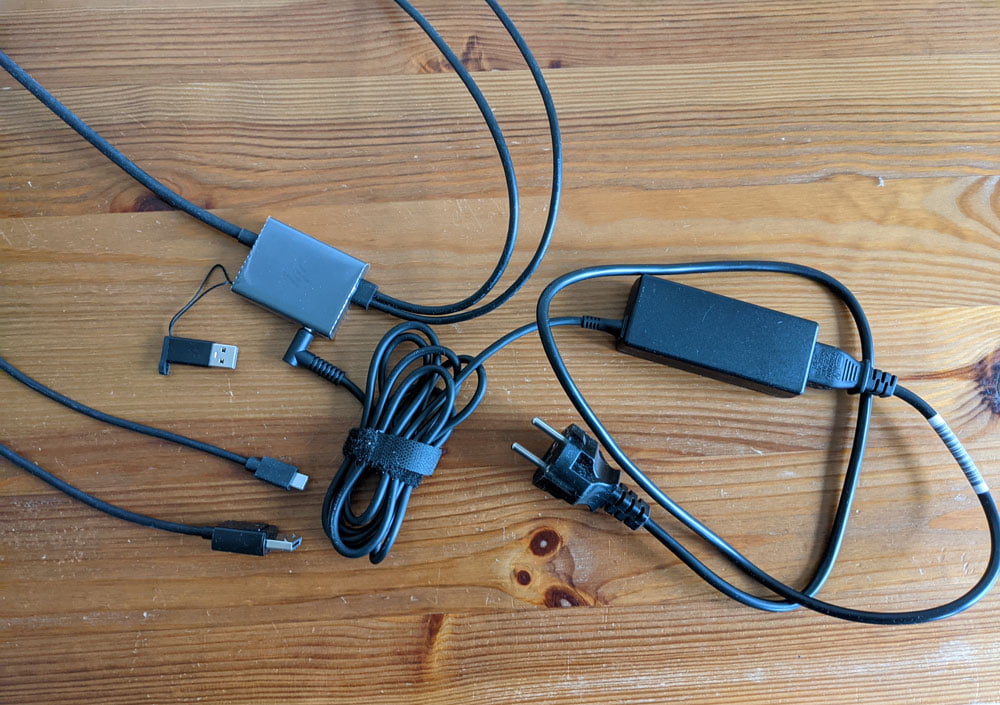
HP's Reverb is connected via Displayport and USB-C (or USB-A adapter). Power is supplied via a small breaker box with a power adapter. | Image: MIXED
According to HP, the two head speakers correspond to those of Valve Index. Their sound quality and the high wearing comfort due to the distance to the ear are a big bonus of Index for me.
Although the HP version is supposed to be identical in construction, I had two issues in practice: At certain frequencies, I perceived distortions in the sound that I don't know from Index. And I could never place the head speakers exactly above my ear. Since they don't lie on the ear, exact positioning over the ear is especially important for perfect sound. However, I am missing a few millimeters vertically with the HP headset.
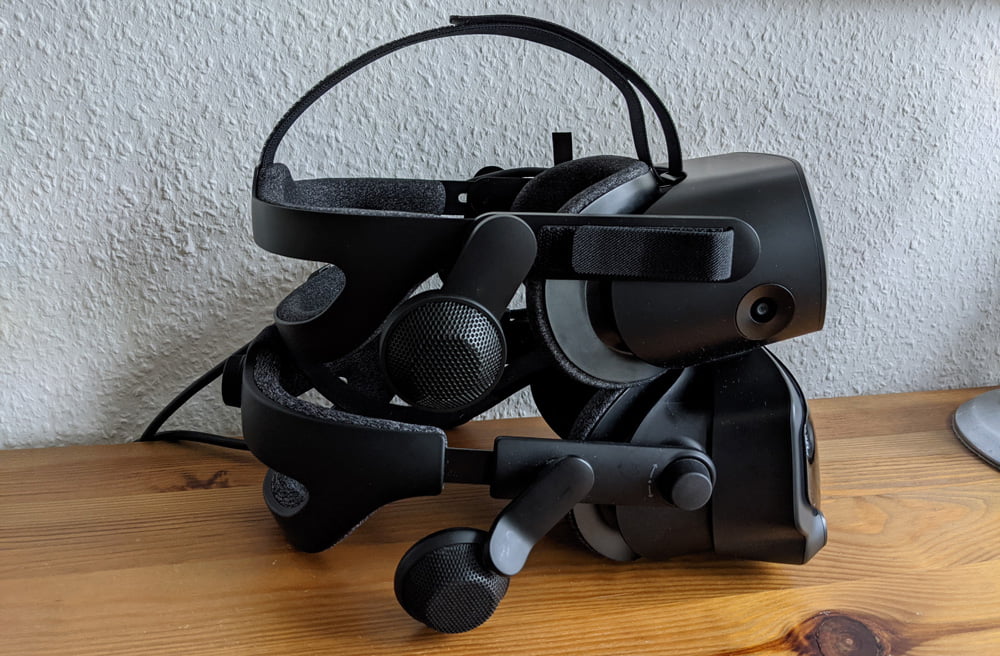
The head mount of Reverb G2 is similar to that of Index, but it has a mechanical adjustment. HP has also adopted Valve's head speakers. However, their mount is a bit shorter. | Image: MIXED
With the changes to the head mount, HP has changed something about the head speaker's headroom. So, depending on the head size and shape, you may not be able to fully enjoy the otherwise high-quality audio solution.
Another small setback compared to Index is the integrated microphone: When recording, Reverb G2 overdrives slightly and sounds a bit tinny even after adjustments. All in all, however, the recording quality is okay.
Setup and software
Like the predecessor, HP's Reverb G2 is based on Windows Mixed Reality, so the setup and the software that works in the background are natively built into Windows 10.
After connecting the VR headset, the Windows Mixed Reality portal opens and a guide leads the user through the setup of the VR headset and the gaming area. In the system settings of Windows 10, you can find settings for the VR mode: Here, the user can change the refresh rate, visual quality or the resolution of the application window.
The Windows Mixed Reality portal offers different rooms that can be set up according to the user's own preferences, and a dedicated store for VR games. The portal always runs in the background: Pressing the Windows key on the controller starts functions like quick access to the desktop. However, those who use the WMR bridge to SteamVR will only use these options very rarely – if at all.
Using HP Reverb G2 with Steam is simple: Launch Steam, install the Windows Mixed Reality for SteamVR app, start SteamVR and you are ready to go.
Since I'm used to SteamVR, in practice the Windows integration is an extra, annoying layer of software that I don't need. However, the working SteamVR compatibility allows me to avoid it for the most part.
VR controller and tracking quality
Besides the much better comfort compared to the predecessor, there is another pleasant news: HP Reverb G2 is the first Windows Mixed Reality headset that comes with improved tracking and VR controllers.
The revamped VR controllers feel much better in the hand than the angular Windows Mixed Reality controllers of the past. They also finally offer analog sticks instead of touchpads and a sensitive button layout. HP has clearly taken its cue from Oculus Touch here – which is good.
The tracking rings of the controllers are unfortunately still huge. That makes the input devices quite clunky and VR interactions often lead to collisions, since you easily bump into each other or objects with the rings. Buttons with proximity sensors like in Oculus Touch or the Index controllers for rudimentary finger tracking are completely absent with Reverb G2.
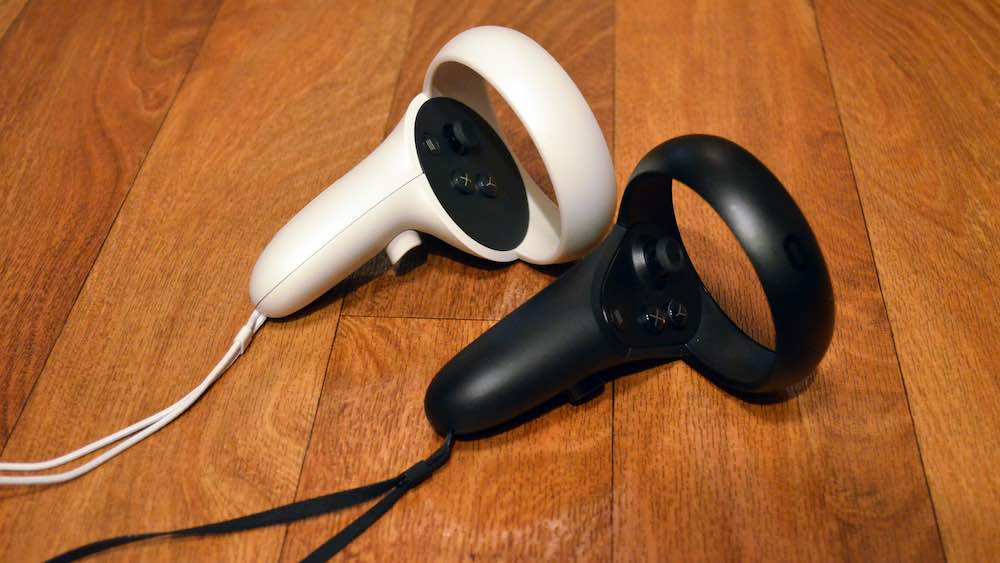
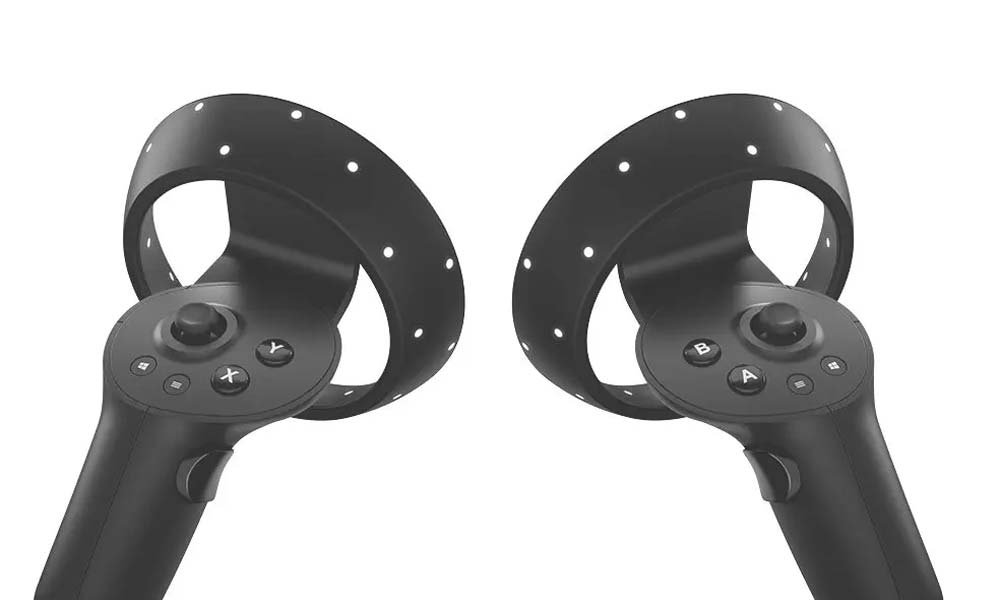
The new HP Reverb G2 controllers (below) were clearly inspired by Oculus Touch (above) and are a significant improvement over the predecessor. Unfortunately, HP still relies on the wide tracking rings of the WMR tracking. | Image: HP
The tracking is better than in the predecessor model: HP has installed two additional cameras on the sides of the VR headset for this. The predecessor only had cameras on the front. The controller tracking is thus much better than with G1 because it is farther, but it does not reach the accuracy of the Oculus or Index tracking.
The tracking glitches are particularly noticeable when you use hands at hip or stomach level to operate interface elements like the browser or the SteamVR overlay, hold a weapon with two hands, or lift your guard in a boxing game. Then, the virtual hands float away or simply get stuck, for example.
This makes interaction even more difficult besides the thick tracking rings: In VR boxing, for example, the right fist gets stuck in front of the punching bag when I quickly move to the side. This sometimes makes simple VR interactions a patience chore and disturbs the immersion. Microsoft urgently needs to develop a better tracking solution. Meta Quest 2 (review) proves that good tracking is technically possible with four integrated cameras.
The headset itself tracks reliably, as long as you do not attempt to play in the twilight – but this limitation applies to all VR headsets with optical tracking cameras directly in the frame.
Review summary of the HP Reverb G2 VR headset
For just under $600, HP's Reverb G2 delivers the VR headset with the sharpest image. In addition, there is a good wearing comfort and a good-sounding audio solution. HP unfortunately inherits the biggest weakness from the predecessor: the mediocre controller tracking.
Nevertheless, for casual VR gamers looking for PC VR headsets, the controller tracking is sufficient. And Reverb G2 offers strong image quality at a fair price. However, Beat Saber experts and passionate shooter gamers will not be able to ignore the obvious weaknesses.
They will have to reach for another VR headset or choose the "silver bullet" solution and combine the Valve Index controllers including the corresponding SteamVR tracking system with Reverb G2. This impressive upgrade unfortunately costs between $400 and $600 additionally and requires a receiver (HTC Vive, Valve Index or SteamVR dongle of the Vive Tracker).
However, those who already own a Valve Index including controller and base stations do not have to pay extra and the setup via software is relatively quick thanks to the detailed tutorial by Reddit user PumkinSpiceTrukNuts. Interested users can also find all the details about the required software and hardware there.
Simulation fans, on the other hand, can use HP's Reverb G2 without hesitation: They usually do not need the VR controllers anyway and place the highest value on the image sharpness. Thanks to the high resolution, they are rewarded with an immersion that even Valve Index with a wider field of view cannot deliver. Those who were annoyed by the G1's teething troubles will be especially happy about the G2's much more homogeneous and clean image.
With Reverb G2, HP has established itself as a relevant manufacturer on the small PC VR market, despite the pre-order chaos. Thanks to the cooperations with Microsoft and Valve, HP was able to raise the VR headsets to a new level, and the company also listened to customer feedback about G1.
For the B2B sector, the tracking difficulties are probably not a problem in most application scenarios. HP is also planning the special Omnicept variant for businesses, which will offer eye tracking, camera-based face tracking and a heartbeat sensor in addition to the standard G2 strengths.
My wish list for the G3: Finally build decent controllers and improve their tracking. Then HP would have a candidate for the best PC VR headset on the market.
HP Reverb G2 is suitable for you if …
- you are looking for a good VR image,
- you are a simulation fan,
- and your graphics card is looking for a challenge.
HP Reverb G2 is not suitable for you if …
- you value accurate tracking in any situation without crafting,
- you want to use VR headsets wirelessly or stand-alone,
- and you value a wide field of view.
You can get HP Reverb G2 here
Datasheet: HP Reverb G2
Note: Links to online stores in articles can be so-called affiliate links. If you buy through this link, MIXED receives a commission from the provider. For you the price does not change.